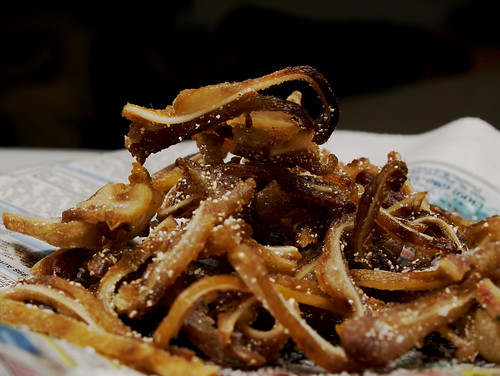
Pig's Head with Torch

Crispy Pig's Ear with Salt and Cornmeal
Last night was a night I had been looking forward to for some time; the chance to cook a bit of simple English countryside fare, the boiled pig's head. It's not actually boiled, of course, but rather simmered in water seasoned with two onions, two carrots, two stalks of celery, two leeks, the zest of two lemons, a handful of black peppercorns contained in a bit of cheesecloth, two bay leaves, and a handful of fresh herbs. This is the standard method as favored by Chef Fergus Henderson. My good friend Josh was along for the ride, just as excited as I.
Our pig's head came already shaved by the butchers at La Esquinita, saving me some time. I touched up a few spots they missed, and singed the rest of the hairs with a quick blast of a blow torch. The butchers had already opened up and shaved the ears, which was nice, and I cut them off and cooked them along with the head. The ears were simmered for an hour, while the rest of the head was simmered for about 2.5 hours, or until the cheeks began to separate from the skull.
After the first hour, I carefully removed and dried the ears. I julienned them and deep fried them at 375ºF. Be very careful if you attempt this as the oil WILL splatter. My best advice is to drop them in the oil, stir them quickly, and cover with a lid to keep the oil at bay. Definitely keep a fire extinguisher handy, because this can get out of control. Fry them for a minute or so, and remove to an oil wicking rig (I like newspaper, but many people frown on that). Salt immediately. Be careful not to fry them too crispy. I fried the first batch a little too much, and they became rather chewy (they will, of course, be a little chewy, but that's part of the charm).
Crispy Pig Ears are 100% delicious. They make an excellent snack or garnish for a variety of foods. Pig's ears can be found frozen at Alwan's if anybody is interested. I strongly urge you to try these, and I plan to pick some up next time I get over there. Really, they are very tasty, and even if you're grossed out by any of the other meats, try the ears. Just do it.
An hour and a half later, the rest of the pig's head came out. Believe me, this is no easy feat. It was quite humorous to see Josh struggling with this pig's head trying not to rip the skin, drop it, or burn himself. He accomplished two of the three goals. As I began to carve the head, we came across many different meats, fats, organs, and other delicacies. I say "other" because I'm not sure how to classify the snout. It's not really fat, but it's not meat either; just really sticky, like so many other parts of the head.
You might want to make a nice vinaigrette and coat some decent greens, as well as the meat, to make a lovely salad. Top with the crispy pig ears to add a contrast in texture. If you don't want to eat all the extra fat (and I don't blame you), render it down and make lard. It's really easy, and lard has much less saturated fat and cholesterol than butter! Believe me, I had to look it up (lard, however, has a few more calories).
Eating this pig's head was an experience I'll never forget, and will definitely do again. The richness is almost over the top, and I definitely wouldn't consume this before getting your cholesterol checked. There wasn't as much meat on the head as I had imagined, but Josh and I were very full by the end of the night. Josh's favorite portion was the cheek meat, and mine was probably the meat just under eyes on the side of the snout. I don't think there was anything that we didn't try. We even ate the roof of the pig's mouth after Josh jokingly suggested we do so. The ultimate epiphany of the night, however: eyeball trumps tonsils, hands down.

